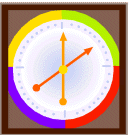
Measuring Climate
 Climate is usually described in terms of the familiar elements of the weather. Temperatures and precipitation (rain, sleet, snow and hail) are the essential indicators, but others include sunshine, wind, cloud cover, atmospheric pressure and humidity. When these elements are measured systematically at a site over a period of several years, we eventually accumulate a record of observations from which we can construct an accurate summary of the climate of that location. Using a variety of statistical techniques, we can compute averages for different climate elements as well as measures of variability and the frequency of occurrence of more extreme events.
Climate is usually described in terms of the familiar elements of the weather. Temperatures and precipitation (rain, sleet, snow and hail) are the essential indicators, but others include sunshine, wind, cloud cover, atmospheric pressure and humidity. When these elements are measured systematically at a site over a period of several years, we eventually accumulate a record of observations from which we can construct an accurate summary of the climate of that location. Using a variety of statistical techniques, we can compute averages for different climate elements as well as measures of variability and the frequency of occurrence of more extreme events.
Information from climate stations within one country can allow a picture of regional climate to be built up. Sometimes scientists bring together data from all over the world to study the climate of the whole Earth, for example when investigating global climate change.
Websites
Other topics
US Climate Data Center
Temperature Extremes
Rainfall Extremes
Introduction
Air Masses
Average Weather
British Climate
Climate Change
Climate Zones
Climatology
Continental Climate
Desert Climate
El Niño
General Circulation
Global Climate
Gulf Stream
Ice Sheets
Land & Sea
Latitude
Local Climates
Maritime Climate
Measuring Climate
Mediterranean Climate
Monsoons
Mountains
Oceans
Polar Climate
Pressure Patterns
Prevailing Winds
Rainfall Patterns
Regional Climates
Savannah
Seasons
Temperate Climate
Temperature Patterns
Tropical Climate
Wind Belts
 Print Topic
Print Topic